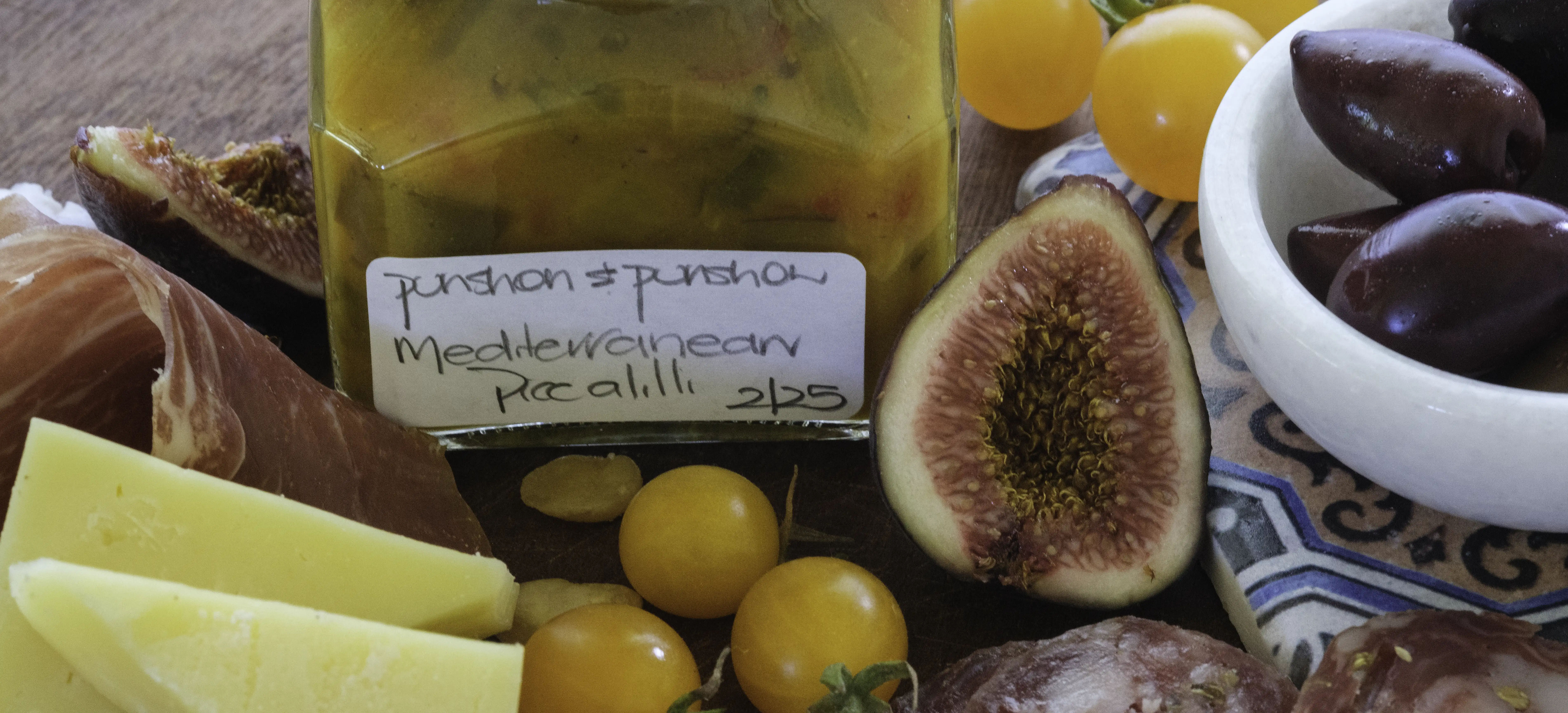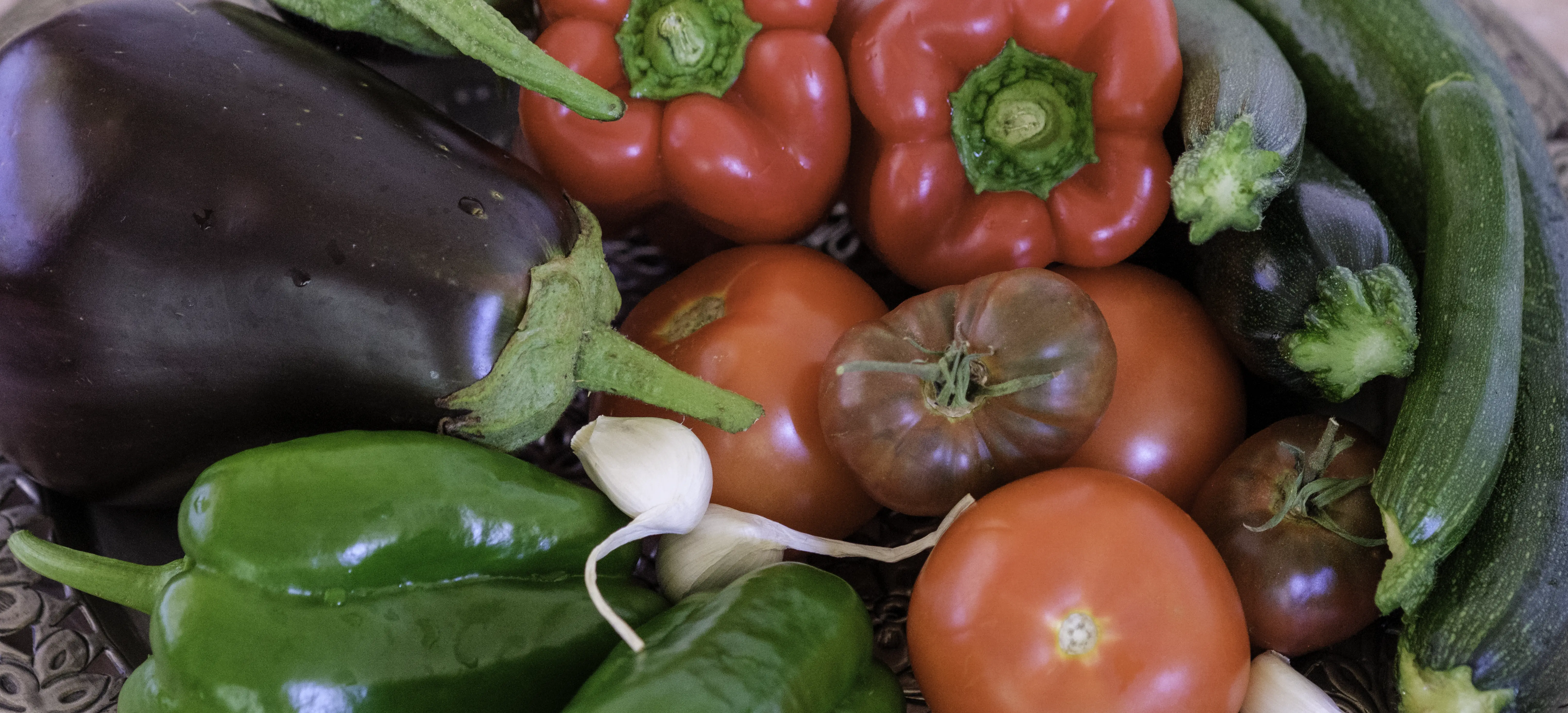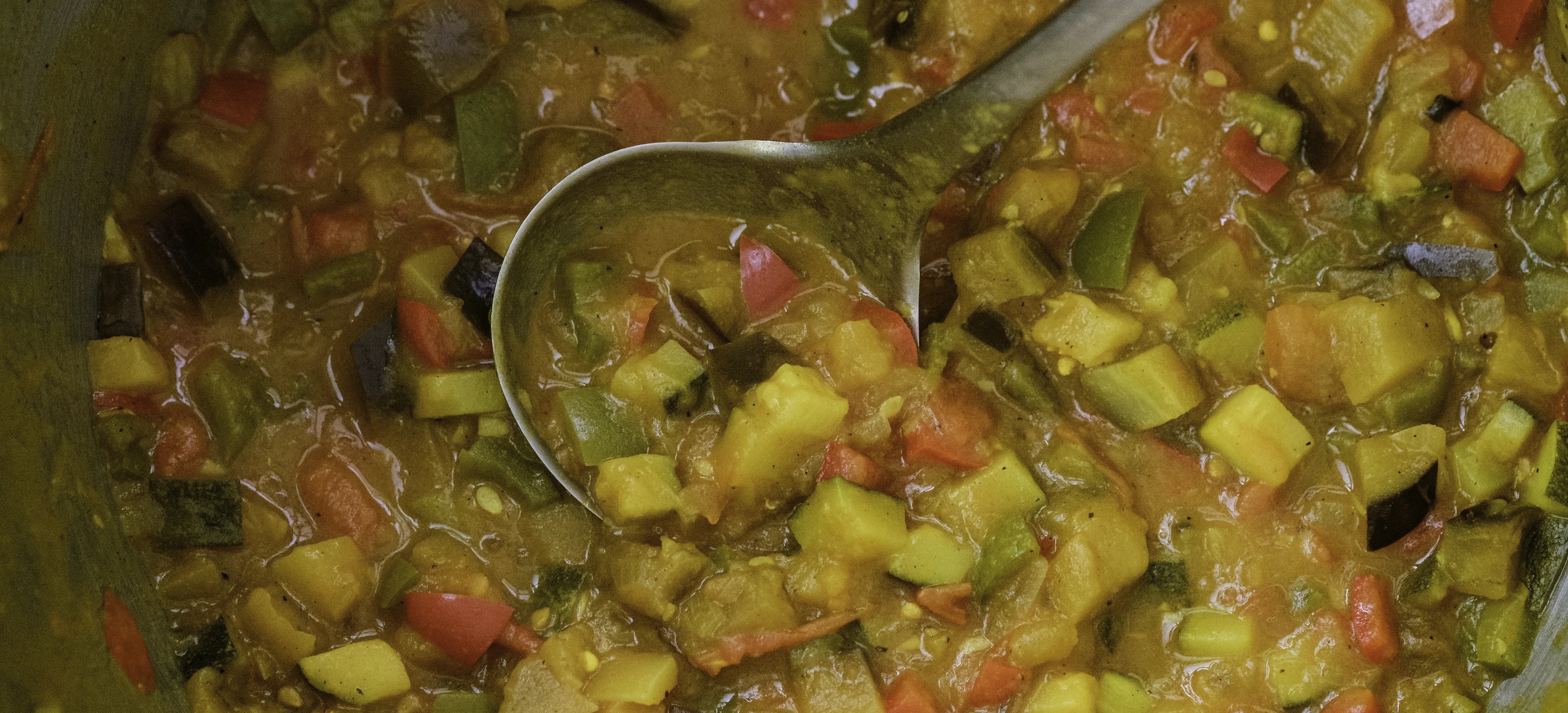Mediterranean Piccalilli

This colourful medley of Mediterranean vegetables is a delightful alternative to the standard English tangy mustard cauliflower and bean variety. Purple eggplant, red and green capsicums, verdant zucchini, brilliant red tomatoes, all cooked so they still have a slight crunch factor, will look magnificent on your table. Make the most of the abundant veggies at summers peak or at the beginning of autumn. This is an unusual accompaniment to antipasto or charcuterie platters, BBQ’s and any dish that needs a boost, regardless of the season. Don’t count the number of spoonful’s you take from the jar, just enjoy it.
- Preparation Time:
- 45 minutes
- Cooking Time:
- 30 minutes
- Quantity:
- 8 x 500ml jars
PREPARATION
Sterilise glass jars and lids with a protective lining. Have the jars and lids dry, hot, and ready for the bottling stage. Here's my quick reference guide on sterilising glass containers.

INGREDIENTS
- 350 g
- Brown onions, peeled, chopped
- 2
- Garlic cloves, medium
- 3 tablespoons
- Vegetable oil
- 700g
- Zucchini, cubed
- 325g
- Red capsicum, cubed
- 250g
- Green capsicum, cubed
- 700g
- Eggplant, cubed
- 700g
- Tomatoes, ripe
- 600 ml
- Apple cider vinegar
- 1 1/2 teaspoons
- Turmeric powder
- 1 teaspoon
- Black pepper, freshly ground
- 1 teaspoon
- Cooking salt
- 1/2 teaspoon
- Cinnamon, ground
- 1/2 teaspoon
- Nutmeg, freshly grated
- 175g
- Sugar, white
- 2 teaspoons
- Arrowroot powder

METHOD
Gently wash and dry all vegetables, except the onion and garlic, to remove any shop or garden dust and debris. Peel the onions and garlic and finely chop.
Remove the core, membranes and seeds from the capsicums and cut into cubes approximately 1 cm square. Put aside.
Top and tail the zucchini and eggplants, cut into the same sized cubes. If the vegetables are not the same size, they will cook at different rates resulting in a piccalilli comprised of mixed textures. This will not affect the flavour, however one of the defining features of a well-made piccalilli is the vegetables all have the same slight crunch and are definitely not mushy.
Remove the core from the tomatoes and roughly chop.
Cover the bottom of a stainless-steel preserving pan, or heavy bottom stainless steel pot, with the vegetable oil.
Gently fry the onion and garlic together until translucent.
Add the remaining vegetables, turmeric, freshly ground black pepper, salt, cinnamon, and freshly grated nutmeg to the preserving pan. Stir well and allow to gently fry for approximately 10 minutes or until the vegetables just begin to soften.
Add the vinegar and simmer gently, stirring occasionally, until the vegetables are just cooked through but not mushy.
Add the sugar and stir until it's dissolved. Continue to simmer for approximately 5-10 minutes, only if required, to ensure the vegetables are cooked through.
Place the arrowroot in a small mixing bowl, add a couple of teaspoons of water to make a thin paste. Add to the piccalilli and simmer for 2 minutes, stirring gently to ensure the starch in the arrowroot is cooked and to prevent the piccalilli from burning on the bottom of the pan as the mixture thickens. When the mixture cools down, it will set slightly thicker than when the mixture is hot.
Use the HHH method (refer the Notes section below), to jar up the piccalilli.
Use a funnel to pour the Hot piccalilli, into the Hot dry sterilised jars. Fill to approximately 2.5cm (I inch) from the top of the bottle. Seal immediately with Hot dry lids.
Allow to cool and wipe the jars down to remove any spills during the bottling stage.
Label and store in a cool dark place in the kitchen or pantry.
Allow to mature for at least 4 weeks before eating.
Once opened, store in the fridge and use within 2-3months.
NOTES

- Good quality jars should be used in all preserving, particularly when they are processed in a hot water bath. Thin jars often cannot withstand the temperatures and may crack either in the bath or/on and or/after removal. Avoid the disappointment and invest in good jars from a homewares or preserves outlet. Select jars that have non-reactive lids as the vinegar solution can cause the lids to rust over time.
- Choose clean ripe vegetables. Do not use overripe and never use mouldy vegetables as this will produce a poor-quality piccalilli.
- If you want a chunkier piccalilli texture, cut the veggies into larger pieces. To ensure even cooking and consistency make sure they are all cut to the same size.
- Salt
- Use good quality pickling salt when making pickles and preserves. Many commercial salt brands contain stabilisers and anti-caking agents and often iodide which forms a whitish haze and sediment. These additives and, in particular, iodine can affect the appearance and taste of pickles and preserves during the maturation and storage period.
- The ingestion of a cocktail of anti-caking chemicals such as calcium silicate, sodium silicoaluminate, tricalcium phosphate, magnesium carbonate, silicon dioxide and yellow prussate of soda, is also unnecessary.
- Read the label before buying and look for salt that is free from any artificial additives. My favourite is Olsson Cooking Salt. No commercial benefit is received from Olsson Salt.
- Cooking times are an approximation only. They are provided as a guideline as cooking times are influenced by the type of pot and its diameter and height, speed of cooking and the ripeness, size, and moisture level of the vegetables. Cooking time will depend upon:
- The size of preserving pan - the broader the pan the quicker the evaporation
- Degree of produce ripeness – the riper the produce, the sweeter and juicer the initial preserve will be.
- The degree of heat when cooking – the higher the heat, the greater the boil which will produce greater evaporation.
- Seal the piccalilli while it’s hot with hot dry lids. The HHH method of HOT dry jars, HOT dry lids and HOT produce creates a vacuum seal as it cools. The “popping” sound, often heard in the kitchen, signals a successfully vacuum sealed jar.
- The HHH method of sealing is preferred as there is reduced risk of contamination prior to sealing.
- This is my quick reference guide to sterilising glass containers
- Types of sugar & vinegar
- The type and colour of the sugar and vinegar used will affect the final colour and flavour of the preserve. Malt vinegar and brown sugar will produce a dark brownish red chutney with a more earthy/molasses background flavour, while white wine or apple cider vinegar and white sugar will produce chutney that has a fresher and brighter flavour.
- This is a matter of personal choice; however, a well-made piccalilli should have a bright vibrant colour.
- Take care to only use vinegar which has a 5% minimum acetic acid content. The acetic acid content acts as the principal preservative, and a lower percentage will compromise the safety of your preserves.
- Commercially available vinegar is 5%, however most homemade vinegars do not achieve this level.
- Arrowroot is a starch extracted from the rhizomes of several tropical plants.
- It's a fine white powder and often used as a last-minute thickener.
- Blend with water by adding a small amount of cold water to the arrowroot and mix to a thin paste. Mixing the arrowroot and water together is often referred to as ‘slaking.’
- Add to hot liquid and bring to boiling point. Remove immediately as further cooking makes the arrowroot thin down slightly.
- It cooks out to be clear, whereas corn-starch gives a cloudy sauce.
KNOWING YOUR SPICES
- Cinnamon (Cinnamomum verum)
- It contains sweet and aromatic flavours. It does not taste sweet, rather, it enhances the perception of sweetness in other ingredients. It draws out the sweet notes in savoury dishes. Cinnamaldehyde is the main flavour compound and is sensed by the temperature sensors on the tongue, giving cinnamon a warming quality.
- Cinnamon sticks keep their flavours for up to a year. Keep in an airtight container and store in a cool dark place in the pantry or kitchen. The lighter brown, thinner more fragile sticks are higher quality.
- Garlic (Allium sativum)
- Raw garlic has a sharp acrid taste, however when cooked it takes on a sweeter flavour and is not overpowering. It has the unique ability to heighten the flavour of the ingredients it is combined with and is indispensable in the kitchen. Interestingly though, the way garlic is prepared will affect its flavour profile.
- There are two types of garlic- hardneck and softneck. Hardnecks grow with a stem that comes from the centre of the bulb and when harvested and cured, the stem becomes rigid and easily identifiable when pulling the cloves off. Softnecks have leaves rather than a central stalk, so there in no rigid stem in the middle of the bulb.
- Fresh garlic should be stored in loose netting or basket in a cool, dry, and well-ventilated place. Do not store in a paper bag.
- Garlic’s flavour, pungency and moisture content will deteriorate over time. Dried garlic and garlic powder are available and should be stored in an airtight container.
- Peppercorns – Black, White, Green (Piper nigrum)
- Peppercorns come from a perennial tropical climbing vine which is native to Southern India. Commercially the vines are pruned to 3-4 metres and the berries are formed on a slim, densely populated cylindrical flower cluster-botanically referred to as a catkin. Or a spike to the lay person.
- The berries of the piper vine are picked at various stages and processed differently to produce, green, white, and black peppercorns. Black peppercorns are produced by drying underripe berries, which leaves their characteristic browned, wrinkled outer layer intact. Black peppercorns have a pungent heat, and a woody aroma with floral, fruity, and citrus elements. It’s also available as ground black pepper.
- White peppercorns are produced by removing the outer layer before drying. The peppercorns remain a creamy colour as the enzyme in their outer layer have been removed. White peppercorns have a harsher and less aromatic flavour. It’s also available as ground white pepper.
- Green peppercorns are produced by harvesting the fruit while green and treated with salted water before being dried. They remain dark green and shrivel to the same texture of dried black peppercorns. They have a lighter fruitier flavour and have a more subtle heat that is short lived on the palette. Green peppercorns are available as dried berries or canned in a salt solution.
- Turmeric (Curcuma longa)
- Turmeric is a leafy tropical plant of the ginger family. The fresh leaves are used as an herb or to wrap foods in, however the rhizome (root) used, either fresh or dried as a powder, is more widely known.
- It has a woody, floral, bitter flavour and works particularly well in complex blends where its pungent flavour acts as a foundation which binds the other flavours together.
- It’s often used to colour relish mixtures with an intense yellow colour. If too much is used by itself, its bitter notes can be overwhelming.
